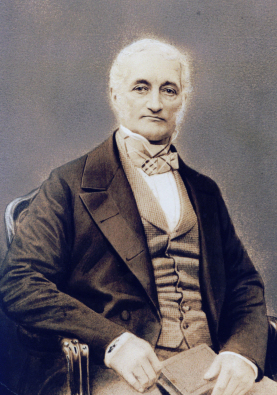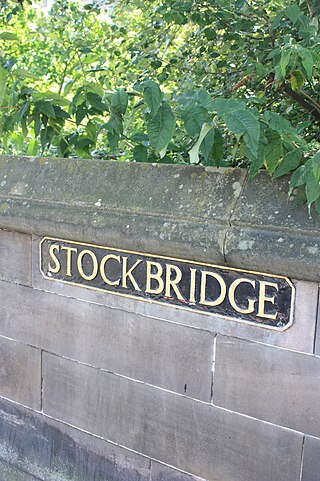
William Blackwood was a Scottish publisher who founded the firm of William Blackwood and Sons.

Sir John Robert Steell was a Scottish sculptor. He modelled many of the leading figures of Scottish history and culture, and is best known for a number of sculptures displayed in Edinburgh, including the statue of Sir Walter Scott at the base of the Scott Monument.

Thomas Hamilton was a Scottish architect, based in Edinburgh where he designed many of that city's prominent buildings. Born in Glasgow, his works include: the Burns Monument in Alloway; the Royal High School on the south side of Calton Hill ; the Royal College of Physicians of Edinburgh; the George IV Bridge, which spans the Cowgate; the Dean Orphan Hospital, now the Dean Gallery; the New North Road Free Church, now the Bedlam Theatre; Cumstoun, a private house in Dumfries and Galloway; and the Scottish Political Martyrs' Monument in Old Calton Cemetery, Edinburgh.

William Burn was a Scottish architect. He received major commissions from the age of 20 until his death at 81. He built in many styles and was a pioneer of the Scottish Baronial Revival,often referred to as the golden age of Scottish architecture.

James Gillespie Graham was a Scottish architect, prominent in the early 19th century.

George Meikle Kemp was a self-taught Scottish architect who designed and built the Scott Monument in Edinburgh, Scotland. The poorly educated son of a shepherd, but showing talents in woodworking as a child, he was apprenticed to a joiner and millwright.

Stockbridge is a suburb of Edinburgh, located north of the city centre, bounded by the New Town and by Comely Bank. The name is Scots stock brig from Anglic stocc brycg, meaning a timber bridge. Originally a small outlying village, it was incorporated into the City of Edinburgh in the 19th century. The current "Stock Bridge", built in 1801, is a stone structure spanning the Water of Leith. The painter Henry Raeburn (1756–1823) owned two adjoining estates, Deanhaugh and St Bernard's, which he developed with the assistance of the architect James Milne. Milne was also responsible for the fine St Bernard's Church (1823) in Saxe Coburg Street. Ann Street, designed by Raeburn and named after his wife, is a rare early example of a New Town street with private front gardens.

Mortonhall is an area of Edinburgh, Scotland, on the south edge of the city.

Robert Reid was the King's architect and surveyor for Scotland from 1827 to 1839. He is responsible for a number of public works particularly the façade of Parliament Square in Edinburgh, which houses the Court of Session. Stylistically he was heavily influenced by Robert Adam, but Reid's style is more austere. The style is now seen as the main character of the northern Edinburgh New Town and without Reid Edinburgh would today be a very different city.

Archibald Elliot was a Scottish architect based in Edinburgh. He had a very distinctive style, typified by square plans, concealed roofs, crenellated walls and square corner towers. All may be said to derive from the earlier local example of Melville Castle by James Playfair. Many of his works have been demolished.

William Bonnar RSA was a Scottish portrait painter.

John Chesser (1819-1892) was a nineteenth-century Scottish architect largely based in Edinburgh. He was described as "the prime exponent of terrace design at the time". A very high number of his works are now category A listed buildings, evidencing the quality of his work, particularly in the West End of Edinburgh.

Alexander Black was a Scottish architect, born in Edinburgh around 1790 who is mainly known for his association with George Heriot’s School, where he acted as Superintendent of Works for most of his active life.

Robert BrysonFRSE was a chronometer and clock maker in Edinburgh. He received the Royal Warrant as Watch and Clock Maker to Queen Victoria.

New Calton Burial Ground is a burial ground in Edinburgh. It was built as an overspill and functional replacement to Old Calton Burial Ground and lies half a mile to its east on Regent Road in Edinburgh, Scotland, on the south-east slopes of Calton Hill. On its southern edge it attaches to the north-east edge of the Canongate in the Old Town. It lies on a fairly steep south-facing slope with views to Holyrood Palace, the Scottish Parliament Building and Arthur’s Seat.

Richard and Robert Dickson were brothers, acting as architects in Scotland in the early and mid-19th century. Whilst most of their work is typified by remote country houses they are best known for their magnificent spire on the Tron Kirk in the heart of Edinburgh on the Royal Mile.

Thomas Brown was a Scottish architect in the early 19th century based in Edinburgh. He is best known for St. Mary's Church, Bellevue, Edinburgh, usually known as Bellevue Church.
William Fowler was a 19th-century Scottish architect closely linked to the northern town of Golspie and the surrounding area.
Alexander Kincaid Mackenzie (1768–1830) was a 19th-century Scottish merchant who served as Lord Provost of Edinburgh from 1817 to 1819.



















